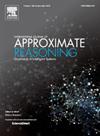Strong consistency and robustness of fuzzy medoids
IF 3.2
3区 计算机科学
Q2 COMPUTER SCIENCE, ARTIFICIAL INTELLIGENCE
引用次数: 0
Abstract
Central tendency of fuzzy number-valued data can be robustly summarized with different proposals from the literature, namely, fuzzy-valued medians, trimmed means and M-estimators of location. In many applications, fuzzy numbers of a specific shape, such as trapezoidal or triangular, are considered, since the chosen shape scarcely affects the value of these summary measures, whenever the ‘meaning’ is basically preserved. Whereas, irrespective of the considered data shape, M-estimators of location under the conditions of the representer theorem and trimmed means would share the same shape, fuzzy medians do not have to. Fuzzy medians must be frequently approximated through the computation of some of their α-levels, whence methods based on them become more complex computationally. All this might discourage users from choosing these measures to describe central tendency. Fuzzy medoids have been recently introduced as an alternative that keeps both the shape of the data and the idea inspiring fuzzy medians, by focusing on the minimization of the mean distance to sample observations, but constrained to the set of fuzzy-valued data. Consequently, it is guaranteed that they always coincide with a sample observation, like it happens (or can be assumed, by convention, to happen) with the median in real-valued scenarios. This work shows the strong consistency of fuzzy medoids as estimators of the corresponding population median (with respect to the same distance) and their robustness in terms of the finite sample breakdown point. Furthermore, some simulation studies have been developed to compare the finite-sample behaviour of fuzzy medoids and other robust central tendency measures.
模糊介质的强一致性和鲁棒性
模糊数值数据的集中趋势可以用文献中不同的建议来稳健地总结,即模糊值中值、裁剪均值和位置的m估计。在许多应用中,考虑到特定形状的模糊数,如梯形或三角形,因为所选择的形状几乎不影响这些汇总度量的值,只要“意义”基本保留。然而,无论考虑的数据形状如何,在表征定理和修剪均值条件下的位置m估计量将共享相同的形状,而模糊中位数则不必如此。模糊中值必须通过计算它们的某些α-水平来频繁地逼近,因此基于它们的方法的计算变得更加复杂。所有这些都可能阻碍用户选择这些度量来描述集中趋势。模糊介质最近作为一种替代方案被引入,它通过关注到样本观测值的平均距离的最小化来保持数据的形状和启发模糊中位数的想法,但受模糊值数据集的限制。因此,可以保证它们总是与样本观察一致,就像在实值场景中发生的(或者可以按照惯例假设发生的)中位数一样。这项工作显示了模糊介质作为相应总体中值(相对于相同距离)的估计器的强一致性以及它们在有限样本分解点方面的鲁棒性。此外,还发展了一些模拟研究来比较模糊介质和其他鲁棒集中趋势测量的有限样本行为。
本文章由计算机程序翻译,如有差异,请以英文原文为准。
求助全文
约1分钟内获得全文
求助全文
来源期刊

International Journal of Approximate Reasoning
工程技术-计算机:人工智能
CiteScore
6.90
自引率
12.80%
发文量
170
审稿时长
67 days
期刊介绍:
The International Journal of Approximate Reasoning is intended to serve as a forum for the treatment of imprecision and uncertainty in Artificial and Computational Intelligence, covering both the foundations of uncertainty theories, and the design of intelligent systems for scientific and engineering applications. It publishes high-quality research papers describing theoretical developments or innovative applications, as well as review articles on topics of general interest.
Relevant topics include, but are not limited to, probabilistic reasoning and Bayesian networks, imprecise probabilities, random sets, belief functions (Dempster-Shafer theory), possibility theory, fuzzy sets, rough sets, decision theory, non-additive measures and integrals, qualitative reasoning about uncertainty, comparative probability orderings, game-theoretic probability, default reasoning, nonstandard logics, argumentation systems, inconsistency tolerant reasoning, elicitation techniques, philosophical foundations and psychological models of uncertain reasoning.
Domains of application for uncertain reasoning systems include risk analysis and assessment, information retrieval and database design, information fusion, machine learning, data and web mining, computer vision, image and signal processing, intelligent data analysis, statistics, multi-agent systems, etc.
 求助内容:
求助内容: 应助结果提醒方式:
应助结果提醒方式:


